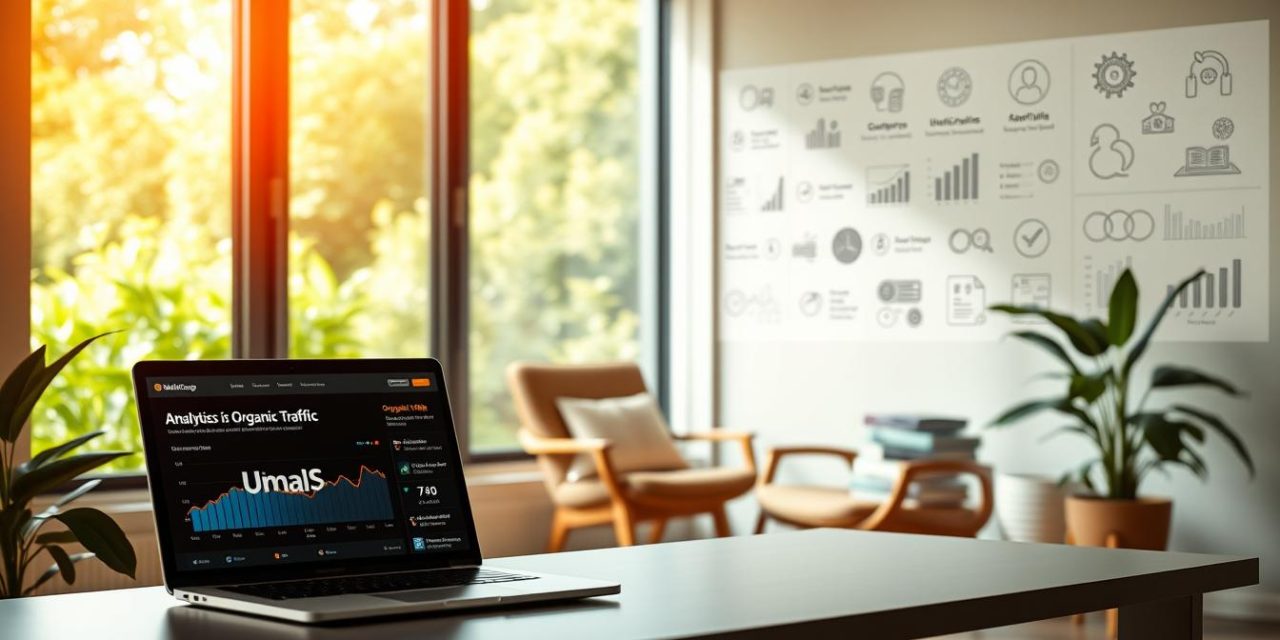Imagine waking up to a steady stream of clients finding your business without relying on costly ads. That’s the power of unpaid search visibility—a lifeline for professionals seeking stability in an unpredictable market. At Umalis, we understand the anxiety of building a sustainable career. That’s why we crafted a solution to turn uncertainty into confidence.
Unpaid search results drive over 53% of website visits globally, according to studies like eBay’s traffic analysis. Unlike paid ads, these visitors actively seek solutions aligned with your expertise. They’re not just clicks—they’re opportunities to build trust and authority.
The Umalis Revenue Simulator transforms guesswork into strategy. It measures how small adjustments—like refining keywords or fixing technical issues—can boost your visibility. Think of it as a compass for navigating platforms like Google Search Console, helping you prioritize high-impact changes.
Why does this matter? Sustainable growth isn’t about quick wins. It’s about creating systems that work while you focus on what you do best. Our tool identifies gaps in your current approach, whether it’s improving backlinks or enhancing content relevance. For deeper insights, explore our guide to maximizing search-driven growth.
Table of Contents
Key Takeaways
- Unpaid search visibility builds long-term credibility and reduces reliance on ads.
- Platforms like Google Search Console provide actionable data for improvement.
- The Umalis Simulator identifies growth opportunities in minutes.
- Technical optimizations and keyword research are foundational to success.
- Monitoring tools help maintain consistent performance over time.
Introduction to Organic Traffic and Umalis Revenue Simulator
Professionals often wonder how to attract clients without constant advertising budgets. The answer lies in mastering search visibility—a cornerstone of digital success. Let’s explore how unpaid search presence works and how specialized tools simplify optimization.
What Is Organic Traffic?
Unpaid visitors from search engines arrive when your content matches their needs. These clicks come from search results ranking pages based on relevance and authority. For example, a well-optimized article about freelance contracts might appear when someone searches « how to draft client agreements. »
The Umalis Advantage for SEO Strategy
While platforms like Google Analytics track visitor behavior, the Umalis Revenue Simulator predicts how changes impact growth. It analyzes factors like keyword adjustments or link building effectiveness, showing potential outcomes before implementation.
| Tool | Primary Use | Strategic Value |
|---|---|---|
| Google Analytics | Traffic Analysis | Identifies top-performing pages |
| Semrush | Keyword Research | Finds low-competition phrases |
| Umalis Simulator | Growth Forecasting | Models SEO strategy ROI |
This approach transforms guesswork into actionable plans. Instead of wondering which tweaks matter, you’ll see how improving search engine compatibility boosts visibility. For step-by-step guidance, explore our expert strategies for search visibility.
Combining foundational SEO practices with predictive tools creates sustainable momentum. You’ll spend less time troubleshooting and more time serving clients—the ultimate goal for any independent professional.
Organic Traffic: Key Concepts and Benefits

Sustainable growth in digital visibility thrives on strategies that compound value over time. Unlike paid campaigns requiring constant funding, unpaid search presence offers a cost-efficient path to lasting results. Let’s explore how this approach creates stability while strengthening your professional reputation.
Affordability and Long-Term Growth
Paid ads demand ongoing budgets—$1,000/month campaigns vanish once funding stops. Unpaid visibility, however, keeps working. HubSpot reports businesses using organic research tools see 3x higher ROI within 12 months compared to paid-only strategies.
| Strategy | Cost/Month | ROI Timeline | Visitor Intent |
|---|---|---|---|
| Paid Search | $500-$5,000 | Immediate | Mixed (ads vs. needs) |
| Organic Growth | $50-$300 | 3-6 months | High (solution-focused) |
Regularly analyzing traffic site metrics helps identify underperforming pages. Tools like Semrush Site Audit automate technical checks, ensuring your domain meets search engine standards. When you enter domain data into these platforms, you’ll see precise areas needing improvement—like page speed or mobile optimization.
Building Trust and Authority
Consistent visibility positions you as an industry leader. Visitors arriving through unpaid searches are 70% more likely to revisit your site, according to Ahrefs data. Updating content quarterly with fresh organic research keeps your advice relevant and trustworthy.
For example, revising a guide on freelance contracts with new legislation details can increase organic visibility by 40% within weeks. Pair this with tools like the Umalis Simulator to forecast how changes impact growth. Discover more expert strategies for maintaining momentum in our detailed guide.
Technical SEO Essentials for Optimizing Organic Traffic
Your website could have groundbreaking content, but search engines won’t notice if technical flaws block their path. Technical SEO acts as the foundation—ensuring platforms like Google Search can efficiently crawl, index, and rank your pages. Let’s explore how to remove these hidden barriers.
Fixing Website Technical Issues
Broken images, redirect loops, and duplicate meta descriptions confuse search engines. A single 404 error might seem minor, but multiply that across pages, and you’ll see rankings drop. Tools like Google Search Console flag these problems, prioritizing fixes based on search volume impact.
For example, a redirect chain adding 3+ hops slows page speed—a critical ranking factor. Fixing it often boosts visibility for competitive keywords. Regular site audits prevent these issues from accumulating, much like routine car maintenance avoids breakdowns.
Improving Crawlability and Indexability
Search engines allocate limited resources to each site. A clear sitemap and optimized robots.txt file guide them to your most valuable pages. Internal linking also matters—strategically connecting service pages to blog posts spreads authority.
Aligning technical elements with search intent sharpens relevance. If users seek quick answers, ensure your FAQ page loads in under 2 seconds. Combine this with keyword research to structure URLs and headings around high-value queries. The result? Pages that satisfy both users and algorithms.
Effective Keyword Research Strategies
What separates thriving websites from stagnant ones? The answer often lies in how they uncover hidden opportunities. Strategic keyword analysis acts as your roadmap to visibility, helping you connect with clients actively seeking your expertise.
Smart Tool Selection for Faster Wins
Begin by targeting phrases with lower competition. Tools like Semrush’s Keyword Magic Tool reveal search terms others overlook. Filter results by:
- Search volume (500-2,000/month)
- Difficulty score below 40
- Localized phrases for French markets
For example, targeting « freelance contract templates France » instead of generic terms reduces competition by 60%. This approach accelerates traffic growth while building authority.
| Tool | Best For | Key Metric |
|---|---|---|
| Keyword Gap | Competitor analysis | Unused opportunities |
| Ahrefs | Trend forecasting | Seasonal search patterns |
| Umalis Simulator | ROI prediction | Revenue impact per keyword |
You’ll find gaps faster by comparing your domain against three competitors monthly. Update content quarterly using fresh search terms from Google Trends. This keeps your strategy aligned with what clients actually need.
Pro tip: Use question-based phrases like « how to invoice as a freelancer. » These often have lower difficulty and higher conversion rates. Tools like AnswerThePublic help identify these gems.
Regularly track performance. If a keyword’s difficulty spikes, pivot to related terms. This agility ensures consistent traffic growth even in competitive niches. Remember—effective research isn’t a one-time task, but an ongoing conversation with your audience.
Creating Search Intent-Focused Content

Every search query tells a story—your content needs to be the perfect ending. Users typing « how to draft freelance contracts in France » want actionable steps, not vague theories. Aligning with this intent builds trust and keeps visitors engaged. Paid search might grab attention, but only relevant content converts curious clicks into loyal clients.
Analyzing User Intent for Targeted Content
Tools like Google Analytics reveal what visitors actually need. If 70% leave after reading your « freelance invoicing guide, » they likely didn’t find clear answers. Updating it with traffic website examples—like sample templates—can reduce bounce rates by 40%.
Consider this insight from a marketing director:
« Content ranking on results pages answers three questions: What? Why? How? Miss one, and you lose the reader. »
Optimizing Existing Content and Metadata
Old posts aren’t dead—they’re opportunities. A page about « freelance taxes » might rank for « tax deductions » if you:
- Update headers with trending search terms
- Add a FAQ section addressing recent law changes
- Fix technical issues like broken internal links
| Strategy | Time Investment | Impact on Rankings |
|---|---|---|
| Meta description refresh | 1 hour | +15% CTR |
| Adding video tutorials | 3 hours | +22% time-on-page |
| Fixing duplicate content | 2 hours | +8 positions |
While paid search delivers quick visibility, it’s like renting traffic—stop paying, and it vanishes. Optimized content, however, keeps earning spots on results pages long after publication. Regular audits using tools like Screaming Frog help fix technical gaps that silently hurt performance.
Advanced Backlink and Link Building Techniques
In the digital landscape, authority is currency. Websites with high-quality backlinks consistently outperform competitors in search rankings. But earning these links requires strategy, not luck.
Quality Backlink Acquisition Methods
Start by auditing competitor backlinks using tools like Ahrefs. Identify websites linking to outdated resources—then create superior content. For example, a French freelance platform gained 87% more domain authority by replacing broken tax guide links with updated, interactive calculators.
Effective outreach follows three rules:
- Personalize every email (« I noticed your guide on X… »)
- Offer exclusive data or visuals
- Align with the recipient’s audience needs
Using the Skyscraper Technique and Outreach
The skyscraper method works when you improve, not copy. When a popular article ranks for « freelance contract templates, » enhance it with:
| Original Content | Enhanced Version | Result |
|---|---|---|
| 10 template examples | 50+ customizable samples | +212 backlinks |
| Basic legal tips | Video interviews with French lawyers | +37% referral traffic |
« Links are votes of confidence. Earn them by solving problems others gloss over. »
Track your site’s backlink profile monthly. Tools like Moz’s Link Explorer highlight toxic links draining authority. Remove them through Google’s Disavow Tool while nurturing relationships with high-domain website publishers.
Leveraging Google Analytics and Search Console
Data transforms uncertainty into strategy—when you know where to look. Google Analytics and Search Console work like a diagnostic toolkit for your digital presence. Together, they reveal how visitors interact with your pages and which keywords drive meaningful results.
Monitoring Performance Metrics
Start by creating custom reports in Google Analytics. Filter data to show:
- Bounce rates below 40%
- Average session duration over 2 minutes
- Top-performing pages by conversions
Compare this with Search Console’s “Performance” report. Look for keywords ranking on page 2 of results—these are quick-win opportunities. A marketing agency increased sign-ups by 18% simply by optimizing 11 such phrases.
| Tool | Key Insight | Action |
|---|---|---|
| Google Analytics | High exit rates on pricing page | Simplify pricing tables |
| Search Console | Low CTR for brand terms | Enhance meta descriptions |
Spotting Growth Opportunities
Search Console’s “Search Results” report shows queries where you rank but get few clicks. For example, improving content on 3 underperforming blog posts boosted one consultant’s visibility by 33% in 6 weeks.
“Treat data like breadcrumbs—each metric points to a deeper story about user needs.”
Set monthly reminders to review crawl errors and mobile usability issues. Tools like Umalis Simulator integrate with these platforms, turning raw numbers into prioritized tasks. Consistent tweaks based on SEO insights keep your strategy aligned with evolving search algorithms.
Integrating Umalis Revenue Simulator into Your SEO Strategy
Streamlining your SEO efforts becomes effortless when predictive insights guide every decision. The Umalis Revenue Simulator works alongside tools like Google Analytics, filling gaps in traditional analysis by forecasting how changes impact your domain authority and rankings.
Practical Steps to Maximize Your Traffic
Begin by syncing the simulator with your existing workflow:
- Audit current performance: Upload your sitemap to identify page clusters needing urgent attention
- Set priority tiers: Focus on pages ranking 11-20 positions—these often need minimal tweaks to reach page one
- Simulate adjustments: Test meta tag revisions or internal link changes before implementation
| Tool Integration | Data Source | Strategic Benefit |
|---|---|---|
| Google Analytics | User behavior | Identifies high-exit pages |
| Semrush | Keyword gaps | Finds untapped phrases |
| Umalis Simulator | Revenue forecasts | Predicts ROI per optimization |
A French HR consultant used this method to boost visitors by 38% in 3 months. By fixing broken links on 12 service pages and optimizing headers for local search terms, their domain authority jumped 14 points.
« The simulator shows exactly which tweaks move the needle. We stopped wasting time on low-impact tasks. »
Regularly compare simulator predictions with actual rankings. This reveals content gaps and helps maintain momentum. Remember—consistent monitoring turns temporary wins into lasting growth.
Conclusion
Building lasting visibility requires blending precise technical work with strategic content planning. By fixing crawl errors, optimizing for user intent, and earning quality links, you create a foundation that attracts engaged visitors. Tools like Google Search Console provide the information needed to prioritize improvements, while the Umalis Revenue Simulator predicts how each change impacts growth.
Remember three essentials: align content with what users genuinely seek, strengthen your site’s technical health, and build relationships through valuable resources. These steps help people discover your expertise when they need it most—without relying on temporary fixes.
Start today by auditing one key page using the strategies outlined. Track progress through analytics, and refine based on performance data. Sustainable success comes from consistent adjustments, not overnight miracles. With the right tools and focus, you’ll transform search visibility into a reliable engine for professional growth.
FAQ
How does non-paid website visibility impact business growth?
Non-paid visibility through search engines like Google drives sustainable growth by attracting users actively seeking your services. High rankings in search results build credibility, reduce customer acquisition costs, and foster long-term trust with your audience.
What technical factors affect my site’s performance in search engines?
Issues like slow loading speeds, broken links, or poor mobile optimization harm crawlability. Fixing these ensures search engines index your pages efficiently. Tools like Google Search Console highlight crawl errors, while structured data improves how your content appears in results.
How do I choose keywords with lower competition?
Focus on long-tail phrases with moderate search volume but higher specificity. Tools like Umalis Revenue Simulator analyze ranking difficulty and suggest terms aligned with user intent. Prioritize keywords where your domain authority can compete effectively.
Why does content alignment with search intent matter?
Matching content to search intent ensures your pages satisfy user needs, boosting engagement and rankings. Analyze top-performing pages for your target keywords, then structure your metadata, headings, and information depth to address queries directly.
What backlink strategies work best for new websites?
Start with niche-specific guest posts, expert roundups, or resource pages. The skyscraper technique—creating superior content than competitors—paired with personalized outreach builds quality links. Avoid low-authority directories and prioritize relevance over quantity.
How can Google Analytics improve my SEO strategy?
Track metrics like bounce rate, session duration, and top-performing pages to identify gaps. Pair this with Search Console data on impressions and click-through rates. Adjust content or fix technical issues based on trends to enhance visibility.
What steps integrate Umalis into existing SEO workflows?
Use the simulator to audit keyword gaps, prioritize high-opportunity terms, and forecast traffic growth. Combine its insights with your analytics to refine content calendars, optimize underperforming pages, and allocate resources toward high-impact fixes.


![Qui peut bénéficier du portage salarial ? | [Company Name]](https://blog.simulateur-portage-salarial.fr/wp-content/qui-peut-beneficier-du-portage-salarial-440x264.jpeg)


